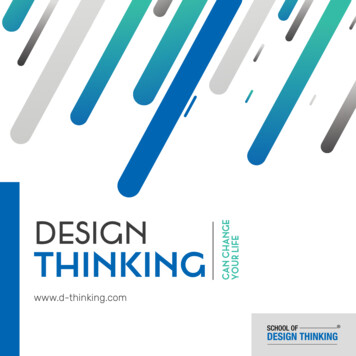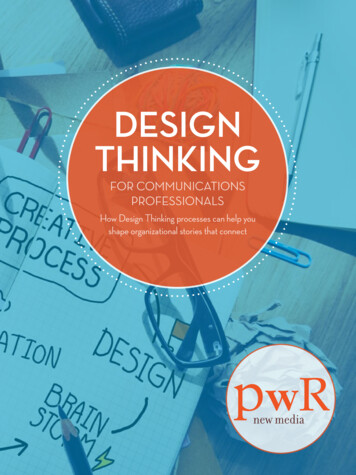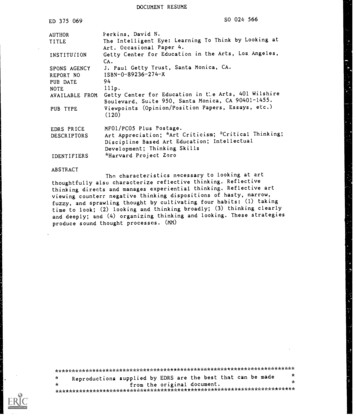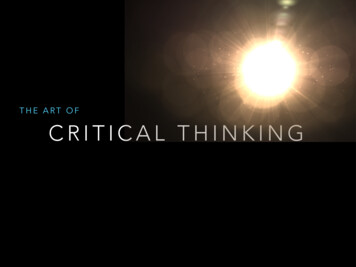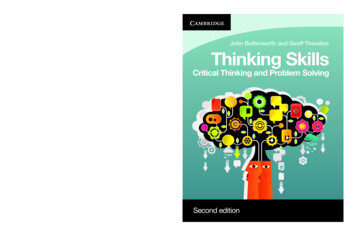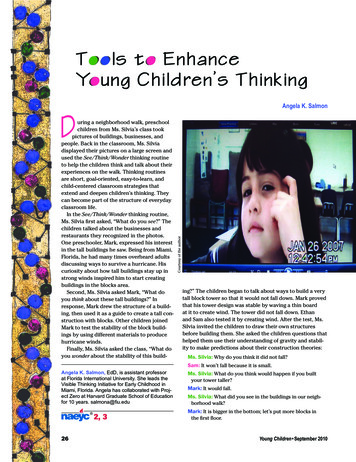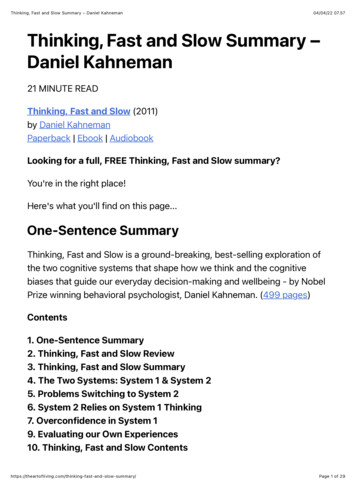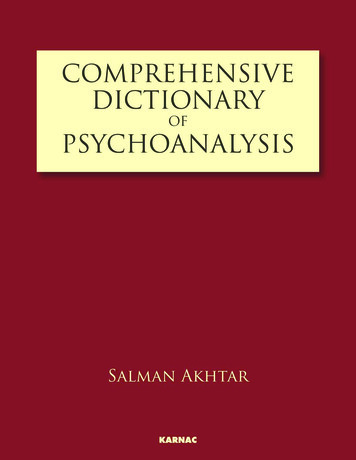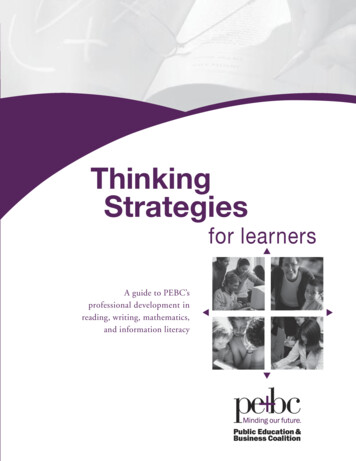
Transcription
ThinkingStrategiesfor learners A guide to PEBC’sprofessional development inreading, writing, mathematics,and information literacy
PEBC MissionThe Public Education & Business Coalitioncultivates excellence in public schools so allstudents succeed in learning and in life.A partnership of leaders from education, business andthe community, the PEBC improves teaching to improvelearning by working increasingly in low-performing K-12schools and classrooms; by collaborating to improveColorado’s policy-making process; and by increasing theinvolvement of business in education.Thinking Strategies for Learners ismade possible through a grant from theHelen K. & Arthur E. Johnson FoundationCopyright 2004, Public Education & Business Coalition, 1410 Grant Street, Suite A 101, Denver, Colorado 80203. www.pebc.org
ThinkingStrategiesfor learners A guide to PEBC’sprofessional development inreading, writing, mathematics,and information literacy
AcknowledgementsEvery river has its source – the same can be said for any body of work.For thoseof us at the Public Education & Business Coalition, our source streams from theearly years when a handful of staff developers – Ellin Oliver Keene, Steph Harveyand Liz Stedem – walked into a few schools armed with loads of books and plentyof questions. The Public Education Coalition’s Literacy League was born out ofa fervent desire to support classroom teachers as they worked to help studentsbecome lifetime readers and writers.For over 20 years, PEBC staff developers and lab classroom teachers have workedin classrooms to refine the content of our professional development model. They,along with countless teaching colleagues, school leaders and students, have broadened and deepened what it means to teach through a thinking lens. Our deepestthanks goes out to each and every one of them. Each has brought his or her ownperspective, passion and sense of wonderment to this important work.This platform was produced through the collaborative effort of many andrepresents our initial thinking, revised thinking, extended thinking. It is a workin progress – and a labor of love.And so the river flows on .Lori L. ConradDirector, Elementary Professional Development
Table of ContentsIntroduction .1PEBC’s Professional Development Model .3Creating a Classroom Culture of Thinking .5Reading .7Writing .17Mathematics .27Information Literacy .35
IntroductionIn 1983, two staff developers were hired by the newly formed Public Education Coalition(PEC) to help elementary teachers put educational research into practice in Denver metro areaschools. Twenty years later, the Public Education & Business Coalition (PEBC) has a differentname and a dramatically different scope, with over 50 teachers and staff developers supportingK-12 teachers across the country. The goal of the PEBC remains the same, however, and staffdevelopers continue to support teachers as they strive to incorporate research-based instructionalpractices into their classrooms.The goal of the PEBC remainsthe same, however, and staffdevelopers continue tosupport teachers as they striveto incorporate research-basedinstructional practices into theirclassrooms.In the late 1980’s, PEBC staff developers began to investigate the research on reading comprehension, looking very closely at the work that identified the specific reading comprehensionstrategies used by proficient readers. This research, conducted and synthesized by P. David Pearson, Jan Dole, and others, provided the foundation for the PEBC’s Reading Project, and PEBCstaff developers once again sought to translate educational research into teacher practice.After experimenting with reading comprehension strategy instruction with many teachers inmany classrooms, Ellin Oliver Keene, former PEBC Associate Director, and Susan Zimmermann, former PEBC Executive Director, published Mosaic of Thought: Teaching Comprehensionin a Reader’s Workshop. Through this book, Keene and Zimmermann not only opened up thePEBC’s rich classroom work in Denver to a national audience, but also clearly defined readingas thinking.PEBC staff developers and lab classroom teachers have since published seven additionalbooks — Nonfiction Matters by Stephanie Harvey, Strategies That Work by Stephanie Harveyand Anne Goudvis, I Read It, But I Don’t Get It and Do I Really Have To Teach Reading?, both byCris Tovani, Reading With Meaning by Debbie Miller, 7 Keys To Comprehension by Susan Zimmerman and Chryse Hutchins, and Writing Through The Tween Years by Bruce Morgan —establishing the comprehension strategies as a critical element of literacy instruction at everygrade level. Accompanying video series – Thoughtful Reading and Comprehending Content,both by Cris Tovani, Strategy Instruction in Action, Think Nonfiction!, and Strategic Thinking byStephanie Harvey and Anne Goudvis, and Happy Reading by Debbie Miller – and numerousarticles have added practical and specific images of the ways comprehension instruction looks inclassrooms at all levels. PEBC staff developers have also published two books — Learning Alongthe Way: Professional Development By and For Teachers by Diane Sweeney, and Pathways: Chartinga Course for Professional Learning by Marjorie Larner – describing ways to create effective professional development for classroom teachers and school leaders.Coupled with these publications and articles, the outstanding work of teachers in PEBCclassrooms has led the PEBC to become a national leader in reading comprehension strategyinstruction and staff development, extending the application of the strategies far beyond thereader’s workshop. As teachers and staff developers continue to work with these strategies, theyhave redefined them as cognitive thinking strategies that proficient thinkers use in every discipline and every academic endeavor.PEBC offers this publication, Thinking Strategies for Learners, as a platform of its staff development work in reading, writing, mathematics and information literacy. The first section outlines1
the professional development model PEBC staff developers employ when working with teachers and school staffs. This is followed by a description of the overarching classroom structuresnecessary for developing a culture of thinking for all students. The remaining sections describethis work embedded in the specific content areas. Each content area section is structured tohelp readers define the content, understand the ways thinking strategies fit with the content,see how the content is most effectively taught, and link the content with specific standardsand assessment practices. There are also classroom vignettes scattered throughout the publication designed to offer a specific window into ways PEBC work looks inside the walls of realclassrooms.What is the PEBC’s Professional Development Model?Current educational research asserts that teacher quality is the single most important factor in student learning (Darling-Hammond and Berry, 1998), so PEBCprofessional development focuses on teachers and classroom instruction. PEBCstaff developers work extensively in individual schools, supporting teachers as theyimplement research-based best practices in their classrooms.PEBC’s professional development work is guided by the following principles: Professional development focuses on topics for which there is an abundance ofhigh-quality research. Professional development evaluation focuses on in-depth teacher and studentgrowth over a long period of time.Professional development is always voluntary and inquiry-based.Professional learning respects the integrity and decision-making rights andresponsibilities of educators: no formulas or prescriptions for success are provided.These principles are applied by PEBC staff developers in conjunction with thestandards established by the National Staff Development Council (NSDC),suggesting that professional development be: results-driven and job-embedded. focused on helping teachers become deeply immersed in subject matter andteaching methods. curriculum-centered and standards-based. sustained, rigorous, and cumulative. directly linked to what teachers do in their classrooms.2
PEBC Professional DevelopmentSince professional development is most effective when it is directly linked to the practices of teachers in their own school settings, most of the PEBC’s work takes place at theschool and in the classroom. Schools typically contract with the PEBC for 20-45 days ofstaff development, for three to five years. This long-term, on-site work includes a planning phase, an implementation phase, and an institutionalization phase.Phase 1: PlanningStaff developers understandthat teachers must makenumerous attempts at a newpractice before consideringthe practice part of apermanent repertoire.In the early excitement about implementing school reform or instructional change,there is a temptation to charge ahead without fully understanding the context inwhich the changes will occur and without building strong consensus to move forward with professional development. Steps toward understanding the context andbuilding consensus should occur early in the process and deserve adequate time andthoughtful planning.Context and Consensus Asset-mapping or another type of needs assessment Study groups to review the research and new instructional practices Support for the principal to build consensus to engage in professional development Staff developer classroom observations and feedback Formation of a leadership teamOnce staff members reach a consensus about engaging in significant professional development, they need to articulate a vision of the classrooms and school they want to create. Inorder to create this vision, teachers need to observe best practices in action. These focused,purposeful observations lead to thoughtful conversations about possible implementationstrategies.Observation and Vision Building Lab classrooms hosted by exemplary teachers and facilitated by PEBCstaff developers3 Guided visitations to other classrooms and schools Early demonstration teaching in study groups and classrooms Continued classroom observations Continued study groups Principal labs Principal study groups Quarterly leadership seminars for principals and teacher-leaders
Phase II: ImplementationEffective professional development encourages a cycle of continuous learning and improvement in practice. Deliberate, thoughtful, and based on well-corroborated research in teachingand learning, PEBC professional development encourages practitioners to experiment, revise,deliberate, and observe. Staff developers understand that teachers must make numerousattempts at a new practice before considering the practice part of a permanent repertoire.Implementation Curriculum planning with teachers Instructional planning with teachers Demonstration teaching by the staff developer Debriefing demonstration lessons Co-teaching, observation, and feedback Analysis and discussion of student work Support for teacher research Collaboration around standards, curriculum, and assessment Continued study groups Intra-/Inter-district teacher, librarian and principal networks In-services with outside experts Participation in PEBC conferences and institutes Parent workshopsPhase III: Institutionalization and Continuous RenewalIn order to create lasting school reform, structures and attitudes both inside and outsidethe school must change. Teachers and administrators must think creatively and purposefully about how to continue to support the changes by re-allocating both time andresources. They must be willing to advocate strongly for policy changes at the building,district and state level that will support their new vision. They must also maintain a spiritof ongoing revision, knowing that the hard work of school reform is never truly done.Structures that Sustain Learning Hosting internal labs Training school-based trainers Continued participation in PEBC conferences and institutes Continued study groups Continued participation in leadership activities Restructuring the school schedule to embed staff development in the school day Reallocating resources to support ongoing staff development Selecting and acting on policy issues relevant to program work4
Culture of ThinkingCreating a Classroom Culture of ThinkingEngaged, sophisticated thinking does not come about by chance. Long-lasting intellectual development occurs when necessary elements come togetherwith artistry and craftsmanship, much like a well-staged performance, an elegant meal or an intricate jigsaw puzzle. In the classrooms and schools activelyparticipating in PEBC professional development efforts, four essential “puzzlepieces” connect as teachers and school leaders work to support student learning. These elements constitute the common thread that ties PEBC classroomsand schools together.Teachers know learning by: studying current research; and working to create a sense of integrity in their instruction.Teachers come to know learners and the learning process by: developing trusting relationships with learners; assessing learners in both formative (ongoing) and summative (final point)ways;developing a rigorous and intimate environment in which learners’ strengthsand needs can be met;articulating the ways in which learners meet and have yet to meet agreedupon standards; andhaving a vision for the long-term goals of all teaching and learning: increasedstudent independence, proficiency and passion for understanding.Teachers embed instruction in authentic contexts by: employing materials, texts and tasks used outside the classroom whenindividuals “do thinking” in the world; making decisions based on the question “would I do this as an adult creating differentiated, relevant work that is worthy, real, and applicable tolearners’ lives; andfocusing instruction on a few concepts over long periods of time.Teachers engage in ongoing, continual reflection by: being passionate about their own learning goals;5 pursuing professional growth independently and alongside colleagues; reading widely; collaborating with others; and seeking out evolution of ideas and beliefs.
Constructing an Environment in Which a Culture of Thinking Can GrowTeachers and school leaders who have actively participated in PEBC professionaldevelopment efforts have come to know that the classroom environment itself isintegral to growing thinking students. Like the rich soil in a well-tended garden,the classroom setting nurtures the seeds of thoughtfulness. In PEBC classrooms andschools, adults and students have constructed learning workshops that honor: the time it takes for deep, long-lasting understanding. They do this by structuringblocks of uninterrupted time for instruction, practice and reflection.learners taking ownership of their learning processes andproducts. In these classrooms, choice is an essential partnerin learning. Students take responsibility for their ownindividual growth, as well as for the collective learning ofthe group.teachersknow learninga learner’s need for response. This feedback takes manyforms, including one-on-one comments generated in aconference, small-group/whole-group sharing and individual reflection. Response can vary across oral, written andartistic formats.teachersknow ofa community built around rigorous expectations,predictable rituals and routines, meaningful and wellorchestrated materials and experiences, and trusting andrespectful relationships.Thinkingteachers embedinstruction inauthentic contextsteachers reflectcontinuously66
ReadingReading is ThinkingMaking sense of print is no easytask. A reader has to weavetogether what is seen on the page(e.g., the letters, words, spaces,punctuation marks) with what isimplied (e.g., the author’s purpose,bias, writing goals).Simply stated, reading is thinking about text. Neurological research, as well asresearch conducted in the fields of education, linguistics, and psychology, clearlydemonstrates that the human mind must process information from many differentsources simultaneously in order to read the words on a page and to make meaningof those words. As the eye scans the page, the mind engages in a number of differentcognitive processes.Reading is MetacognitiveProficient readers are metacognitive: they think about their own thinking whilereading. Proficient readers know when they are comprehending and when they arenot comprehending. They can identify their purposes for reading and the demandsplaced on them by a particular text. They can also identify when and why the meaning of the text is unclear to them, using a variety of strategies to solve comprehensionproblems or to deepen their understanding of the text (Duffy, 1987).Reading is ComplexMaking sense of print is no easy task. A reader has to weave together what is seenon the page (e.g., the letters, words, spaces, punctuation marks) with what is implied(e.g., the author’s purpose, bias, writing goals). It is the resulting tapestry whichultimately allows a reader to understand the story, article, poem or essay. In order toaccomplish this task, readers need explicit instruction on the ways letters and soundsconnect to create words and ideas. They need time to practice in texts that are readable as well as meaningful. And they need access to and immersion in high-qualityreading material in a variety of genres.Reading is Comprehending Words and IdeasWhile reading, the human mind receives information through six cueing systems.These cueing systems provide the reader with both surface structure information anddeep structure information. Readers use surface structure systems to rapidly and accurately identify and pronounce words, as well as to recognize when the structure ofwords and sentences is comprehensible. Simultaneously, readers use deep structuresystems to understand and remember what they have read, as well as to interpret andanalyze text at both a literal and inferential level.Which Reading Skills and Strategies Matter Most?Many theorists believe that the six cueing systems operate in the mind simultaneously, providing the reader with an abundance of information from all six surfaceand deep structure systems at every moment. The reader relies on different sources ofinformation at different times, depending upon the purpose and context for reading.7
Surface Structure SystemsSurface structure systems provide the reader with visible andaudible information about letters, sounds, words, and grammaticalstructure. Grapho-Phonic SystemProvides information about letters, features of letters, combinationsof letters, and the sounds associated with them. Lexical SystemProvides information about words, including instantaneousrecognition of words, but not necessarily including themeanings associated with the words.Syntactic SystemProvides information about the form and structure of the language. The reader notices the structure of words, sentences, andwhole texts, including whether words and longer pieces of text“sound right” and are organized cohesively.Schematic SystemProvides information from a reader’s prior knowledge and personalassociations with the text that permits the reader to understand andremember information from the text. It also governs the grouping andorganization of new information in memory stores.Pragmatic SystemProvides information about the purposes and needs the readerhas while reading, governing what the reader considers importantand what the reader needs to understand for a particular purpose.It also includes “social construction of meaning,” ways in whichgroups of readers discuss text to arrive at shared meaning andincreasingly abstract interpretations of text.As readers work to identify new words and repair word-level confusions, they use their knowledge of the surface structure systems and thefollowing skills/strategies to make sense of words in text: phonemic awareness – awareness of the sounds that make upspoken wordsalphabetic knowledge – knowing that the sounds of our languagehave a direct, but not necessarily one-to-one correspondence, tothe letters of the alphabetword context – using the surrounding words in the sentenceword recognition – developing a “bank” of words knownautomaticallyword analysis – using word parts (e.g., roots, prefixes, suffixes)rereading and reading ahead – using the flow of language andideassentence and text structure – understanding the ways words areput togetherDeep Structure SystemsDeep structure systems provide information about the meaningsof words and longer pieces of text, the purpose for reading, andprior knowledge related to the text. Semantic SystemProvides information about the meanings, concepts, and associations of words and longer pieces of text. It includes the reader’svocabulary and the degree to which the reader has a full conceptualknowledge of words that enable an understanding of subtle definitions and nuances.As readers work to construct meaning from text, they use the followingstrategies at the deep structure level: monitor meaning activate, use and build background knowledge (schema) ask questions draw inferences determine what is important in text create sensory images synthesize information problem solve and repair meaningwhen meaning is interrupted8
ReadingThinking Strategies for ReadersResearchers who have studied the thinking processes of proficient readers conclude thatif teachers taught the following strategies instead of much of the traditional skills-basedreading curriculum, students who use the strategies would be better equipped to deal witha variety of texts independently (Keene and Zimmerman, 1997). These strategies are useful for composing meaning at both a text and word level.Monitoring for Meaningat a text level, readers . . . pause to reflect on their growing understandings recognize when they understand the text, and when they don’t identify when and why the meaning of the text is unclear identify the ways in which a text becomes gradually more understandable by reading past anunclear portion and by rereading text decide if clarifying a particular confusion is critical to overall understanding explore a variety of means to remedy confusion consider, and sometimes adjust, their purpose for reading check, evaluate and make revisions to their evolving interpretation(s) of textat a word level, readers . . . identify confusing words employ a range of options for reestablishing meaningful reading (e.g., rereading, reading on,using words around the unknown word, using letters and sounds, using a meaningful substitution)Activating, Utilizing and Building Background Knowledge (Schema)at a text level, readers . . . activate relevant, prior knowledge before, during and after reading build knowledge by deliberately assimilating new learning with their related prior knowledge clarify new learning by deleting inaccurate schema relate texts to their world knowledge, to other texts and to their personal experiences activate their knowledge of authors, genre, and text structure to enhance understanding recognize when prior knowledge is inadequate and take steps to build knowledge necessary tounderstandat a word level, readers . . . apply what they know about sounds-letter relationships and word parts to make sense ofunknown wordsAsking Questionsat a text-level, readers . . . generate questions before, during and after reading about the text’s content, structure and language 9ask questions for different purposes, including clarifying their own developing understandings,making predictions, and wondering about the choices the author made when composing realize that one question may lead to others pursue answers to questions consider rhetorical questions inspired by the text
distinguish between questions that lead to essential/deeper understandings and “just curious”types of questions allow self-generated questions to propel them through text contemplate questions posed by others as inspiration for new questionsat a word level, readers . . . pose self-monitoring questions to help them understand unknown/unfamiliar words (e.g.,“What would make good sense?”, “What would sound like language?”, “What would soundright and match the letters?”, “Is this a word I want to use as a writer? If so, how am I goingto remember it?”)Drawing Inferencesat a text level, readers . . . draw conclusions about their reading by connecting the text with their schema make, confirm, and/or revise reasonable predictions know when and how to infer answers to unanswered questions“Eventually, the goal is for form unique interpretations to deepen and personalize reading experiencesreaders to use these strategies extend their comprehension beyond literal understandings of the printed pageautomatically and seamlessly.” make judgments and create generalizations about what they read create a sense of expectation as they readHarvey and Goudvis,Strategies That Workat the word level, readers . . . use context clues and their knowledge of language to predict the pronunciation and meaningof unknown/unfamiliar wordsDetermining Importanceat a text level, readers . . . identify key ideas, themes and elements as they read distinguish between important and unimportant information using their own purpose(s), aswell as the text structures and word cues the author providesuse text structures and text features to help decide what is essential and what is extraneoususe their knowledge of important and relevant parts of text to prioritize what they commit tolong-term memory and what they retell and/or summarize for othersconsider the author’s bias/point of viewuse the filter of essential/other to clarify usefulness when applying other cognitive strategiesto their readingat a word level, readers . . . determine which words are essential to the meaning of the text know when choosing to skip words/phrases of text will or will not impact their overall understandingmake decisions about when unknown/unclear words need clarification immediately andaccurately, and when substitutions can be used to maintain meaning and fluency10
ReadingCreating Sensory Imagesat a text level, readers . . . immerse themselves in rich detail as they read “The workshop is both ametaphor and a model for turningclassrooms into learning labora- attend to “heart” images – feelings evoked while reading revise their images to incorporate new information and new ideas revealed in the text adapt their images in response to the images shared by other readersat a word level, readers . . . use visual, auditory and kinesthetic modes when learning how words work tories. In the ancient craftsworkshop, the teacher was amaster craftsperson who demonstrated a trade and coached ap-create images connected to the senses of sight, hearing, taste, touch and smell to enhance andpersonalize understandingsuse what they know about a word’s appearance (e.g., length, spacing above and belowthe line) to understand unknown wordsask themselves “Does that look right?” and “Does that sound right?” whencross-checking unknown wordsSynthesizing Informationat a text level, readers . . . continually monitor overall meaning, important concepts and themes while reading recognize ways in which text elements fit together to create larger meaningprentices in the context of making create new and personal meaningreal products for the community. In contemporary classrooms,we borrow the workshop metaphor to create writingworkshops, science workshops,math workshops, and otherworkshops across the curricu-reading, investigating, or problem solving, while teachers takeon the new roles of mentors,coaches, and models.”Harvey Daniels and Marilyn Bizar,Methods that Matter: Six Structures forBest Practice Classrooms attend to the evolution of their thoughts across time while reading a text, and while reading manytextsknow when certain vocabulary is critical to the text’s overall meaning, and therefore,must be understood if comprehension is to be achievedProblem Solvingat a text level, readers . . . know that once meaning has broken down, that any of the other cognitive behaviorscan be employed to repair understanding use information from the three deep surface structure systems to repair text meaningat a word level, readers . . . use information from the three surface structure systems to solve word issues 11capitalize on opportunities to share, recommend and criticize booksat a word level, readers . . . select specific vocabulary from the text(s) to include in their synthesis because theyknow that specific language is highly meaning-ladenlum. Students get large chunksof time to practice the trade ofdevelop holistic and/or thematic statements which encapsulate the overall meaning of thetextselect from a wide range of word strategies (e.g., skip and read on, reread, use contextclues, use the letters and sounds, speak to a peer reader) to help make sense of unknownwordsdevelop reading fluency
How Do We Teach Reading Effectively?An abundance of research suggests that if teachers focus theirinstruction on a few cognitive strategies, over a long period of time,in a variety of different text genres, students will learn to use thosestrategies independently and flexibly. Successful teachers teach towardindependent mastery by modeling their own use of the strategies andby gradually releasing responsibility to their students (Gallagher andPearson, 1983).The cogniti
and Liz Stedem - walked into a few schools armed with loads of books and plenty of questions. The Public Education Coalition's Literacy League was born out of . Think Nonfiction!, and Strategic Thinking by Stephanie Harvey and Anne Goudvis, and Happy Reading by Debbie Miller - and numerous articles have added practical and specific .


